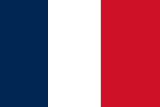Commander-in-Chief, Mediterranean (France)
This article needs additional citations for verification. (December 2009) |

| French Navy |
|---|
 |
| Command |
| Components |
| Equipment |
| Personnel |
| History |
| Awards |
The French Commander-in-Chief, Mediterranean, also known as CECMED (French for Commandant en chef pour la Méditerranée) is a
CECMED today is simultaneously:
- Commander of the région and the Mediterranean maritime arrondissement,
- Maritime Zone commander,
- Maritime Prefectfor the Méditerranean.
Today the main French naval combat force in the Mediterranean is the
History
Mediterranean Squadron
Vice-amiral François Fournier was Commander-in-Chief, Mediterranean Squadron (Commandant en chef l'Escadre de Méditerranée, fr:Escadre de la Méditerranée) in January 1899 aboard Galilée.[2]
On 20 July 1921 after a series of designation changes, the force again became the Mediterranean Squadron.
In September 1939 the fleet included:[6]
- 2ème Escadre (VAE Ollive) : Provence (VAE Ollive - CV Barois)
- 2ème DL : Lorraine * (CA Vallée - CV Aurin) - Bretagne (CV Seguin)
- 1ère FT (CV Longaud) :
- 1ère DT : La Palme ° (CV Longaud) - Le Mars (CC Lamote) –Tempête (CC Pellegrin)
- 3ème DT : Le Fortuné ° (CC d’Hespel)– La Railleuse (CC Hourcade) – Simoun (CC Hainguerlot)
- 7ème DT : Tramontane ° (CF Renault) - Typhon (CC Le Hagre) – Tornade (CC Labat)
- 3ème Escadre (VA Duplat) :-
- 1ère Division de Croiseurs: Algérie *** (VA Duplat - CV Nouvel de la Flèche) - Dupleix (CV Hameury) – Foch (CV Mathieu) - Colbert (ship list as of 1 July 1939)[7]
- 2ème DC : Duquesne ** (CA Kerdudo – CV Husson) – Tourville (CV Marloy)
- 3ème EL (CA Derrien) :
- 5ème DCT : Tartu ° (CV Chomel) - Chevalier Paul (CF Bonnot) – Vauquelin (CF Jaujard)
- 7ème DCT : Vautour ° (CF Reboul Hector Berlioz) - Gerfaut (CF Penet) – Albatros (CF Penet)
- 9ème DCT : Maillé Brézé ** (CA Derrien) - CF Glotin) - Cassard (CF Braxmeyer) – Kersaint (CF Rebuffel)
- 4ème Escadre (CA Marquis) :
- 3ème DC : Marseillaise ** (CA Marquis – CV Hamon) - Jean de Vienne (CV Missoffe) – La Galissonniere (CV Dupré)
- Non endivisionné : Emile Bertin (CV Battet)
The twentieth century history of the French Navy in the Mediterranean includes surveillance of actions during the Spanish Civil War. On 14 June 1940, the 3rd Escadre executed Operation Samoyède. The squadron, including the cruisers Foch, Algérie, Dupleix and Colbert, bombarded Genoa, supported by French Naval Aviation.
In 1940, after the
In the 2020s, French naval forces in the Mediterranean are one element within the Force d'action navale of the French Navy. The force d'action navale is composed of ships based both in the Mediterranean and the Atlantic.[9] However, as of 2022 the majority of the fleet's major combatants are based in the Mediterranean, including:
- Six nuclear-powered attack submarines of the Rubis and Barracuda classes
- The aircraft carrier Charles de Gaulle;
- Three Mistral-class amphibious assault ships;
- Two Horizon-class air defence frigates;
- Four Aquitaine-class frigates; and,
- Five La Fayette-class frigates.
Notes
- Jane'sNavy International, July/August 1998, p.35
- ^ http://ecole.nav.traditions.free.fr/ecoles_commandant_perrin.htm, accessed September 2011
- ^ John Jordan, Jean Moulin, French Cruisers: 1922-1956, 2013
- ISBN 978-2-910366-77-3)
- ^ On Seas Contested: The Seven Great Navies of the Second World War.
- ^ See also Jordan and Moulin, 2013, 174
- ISBN 978-1848321335.
- ^ T.D. Young, Command in NATO after the Cold War, U.S. Army Strategic Studies Institute, Carlisle Barracks, 1997
- ^ Force daction navale Ministry of Defense (in French)
